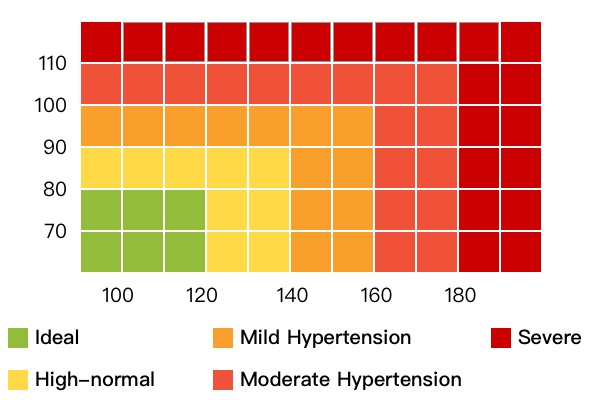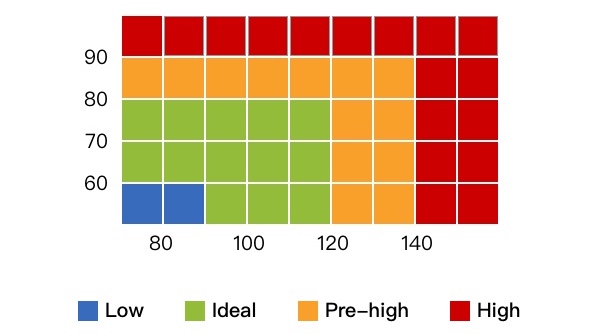Normal Blood Pressure
Blood pressure is the pressure the blood exerts on the vessel wall. It is caused by the heartbeat and the accompanied transport of the blood in the vessels. Normal blood pressure for adults is generally between 90-120 mmHg systolic and between 60-80 mmHg diastolic.
A blood pressure reading consists of two seperate values, the systolic blood pressure (the higher value) and diastolic blood pressure (the lower value). Blood pressure is measured in millimeters of mercury (mmHg) and usually expressed as “systolic pressure over diastolic pressure” (e.g. “120 over 80”).
Contents:
- Blood Pressure Ranges
- What do systolic and diastolic blood pressure mean?
- How to read blood pressure
What is normal blood pressure?
Blood pressure values have been classified into different ranges from low to high by various organisations. Among others, there are definitions from the WHO (World Health Organisation) and NHS (National Health Service). Abnormally low blood pressure is called hypotension whereas abnormally high blood pressure is called hypertension.
Normal blood pressure range (WHO)
The WHO classifies blood pressure values in five ranges as displayed in the following blood pressure chart:
| Systolic (mmHg) | Diastolic (mmHg) | |
|---|---|---|
| Ideal blood pressure | < 120 | < 80 |
| High-normal blood pressure | 120 - 139 | 80 - 89 |
| Mild hypertension | 140 - 159 | 90 - 99 |
| Moderate hypertension | 160 - 179 | 100 - 109 |
| Severe hypertension | ≥ 180 | ≥ 110 |
Blood pressure values below 120 mmHg systolic and 80 mmHg diastolic are considered optimal by the WHO. Values between 120-139 mmHg systolic and 80-89 mmHg diastolic indicate high-normal blood pressure. The blood pressure range between 140-159 mmHg systolic and 90-99 mmHg diastolic is classified as mild hypertension, while moderate hypertension ranges between the values 160-170 mmHg systolic and 100-109 mmHg diastolic. Lastly, there is severe hypertension (greater than 180 mmHg systolic and greater than 139 mmHg diastolic).
Blood pressure ranges are also often visualised using blood pressure charts as displayed below.

Normal blood pressure range (NHS)
The NHS (National Health Service) defines blood pressure ranges as shown in the following blood pressure chart:
| Systolic (mmHg) | Diastolic (mmHg) | |
|---|---|---|
| Low blood pressure (hypotension) | < 90 | < 60 |
| Normal blood pressure | 90 - 120 | 60 - 80 |
| Pre-high blood pressure | 120 - 139 | 80 - 89 |
| High blood pressure (hypertension) | ≥ 140 | ≥ 90 |
As you can see, the NHS (National Health Service) refrains from a classification of high blood pressure values in different stages. Instead, the NHS only defines categories for low blood pressure, ideal blood pressure, pre-high blood pressure and high blood pressure.
The corresponding blood pressure chart for the NHS classification can be found below.

Systolic and diastolic blood pressure
A blood pressure reading consists of two values. The first (and higher) value is the systolic blood pressure. It describes the pressure when pumping blood from the heart into the body. Theis contraction of the heart muscle is called systole or cardiac output phase.
The systolic blood pressure is higher than the diastolic because the pressure to pump the blood away from the heart is greater than the pressure in the relaxation phase which is also called diastole or filling phase.
Accordingly, the diastolic blood pressure is measured when the heart relaxes and the pressure subsides. During the relaxation phase the blood is sucked into the heart and the heart muscle is expanded.
How to read blood pressure
To get a meaningful overview of your values it is important to regularly read and document your blood pressure. A single measurement at the doctor is not sufficient to assess your blood pressure, as this is just a momentary snapshot of your condition. What’s more, readings at the doctor’s office can occasionally be higher due to nervosity, an effect called white coat hypertension.
Before measuring your blood pressure, take a break of at least three to five minutes. Sit on a chair and avoid any effort, as the blood pressure can otherwise increase. Apply your blood pressure monitor on one of your arms (but always use the same arm). Rest your forearm loosly on a table top and start measuring. To avoid measuring errors, it can also make sense to read your blood pressure three times in a row and use the average value for your documentation.
Find the perfect blood pressure monitor for you: The best blood pressure monitors of 2023
The blood pressure can be influenced by many minor influences such as physical exercise, meals or nervosity. Therefore, read your blood pressure regularly at the same time of the day, e.g. 30 minutes after waking up and before breakfast.
Observe the development of your blood pressure over time to get a comprehensive picture of your condition. The blood pressure app Cora Health can help you documenting and analysing your heart health using various charts such as a blood pressure chart or a pulse pressure chart. If one third of your readings is above the pre-high blood pressure stage we advise a visit at your doctor’s (if you haven’t been diagnosed with high blood pressure yet). With Cora Premium you can also send a report of your readings to your doctor.
Learn more about your heart health:
Find out how low blood pressure affects your life, what a good resting heart rate is and what pulse pressure tells about your heart health.
